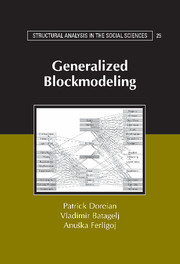Book contents
- Frontmatter
- Contents
- Preface
- 1 Social Networks and Blockmodels
- 2 Network Data Sets
- 3 Mathematical Prelude
- 4 Relations and Graphs for Network Analysis
- 5 Clustering Approaches
- 6 Optimizational Approach to Conventional Blockmodeling
- 7 Foundations for Generalized Blockmodeling
- 8 Blockmodeling Two-Mode Network Data
- 9 Semirings and Lattices
- 10 Balance Theory and Blockmodeling Signed Networks
- 11 Symmetric–Acyclic Blockmodels
- 12 Extending Generalized Blockmodeling
- Bibliography
- Author Index
- Subject Index
- Titles in the series
10 - Balance Theory and Blockmodeling Signed Networks
Published online by Cambridge University Press: 13 January 2010
- Frontmatter
- Contents
- Preface
- 1 Social Networks and Blockmodels
- 2 Network Data Sets
- 3 Mathematical Prelude
- 4 Relations and Graphs for Network Analysis
- 5 Clustering Approaches
- 6 Optimizational Approach to Conventional Blockmodeling
- 7 Foundations for Generalized Blockmodeling
- 8 Blockmodeling Two-Mode Network Data
- 9 Semirings and Lattices
- 10 Balance Theory and Blockmodeling Signed Networks
- 11 Symmetric–Acyclic Blockmodels
- 12 Extending Generalized Blockmodeling
- Bibliography
- Author Index
- Subject Index
- Titles in the series
Summary
In our discussion of blockmodeling in Chapter 6, we presented definitions of equivalences used within conventional blockmodeling. We identified the permitted ideal block types for structural and regular equivalence and outlined an optimizational approach to establish blockmodels according to specified equivalences. Each criterion function measures the inconsistency between the set of empirical blocks and a set of ideal blocks, and we sought partitions by using direct local optimization procedures. In Chapter 7, we suggested starting with patterns of ideal blocks defined for the image matrix with an expanded set of block types. In this chapter, we continue in this spirit by defining some new block types after considering essential elements of structural balance theory.
Our focus shifts to signed networks, a network data type introduced in Chapter 1, with the intent of bringing them inside the generalized blockmodeling framework. It is important to note that this is not an attempt to apply structural equivalence ideas to signed data. In fact, structural equivalence is singularly inappropriate for analyzing signed networks. In certain signed networks (graphs), there are partitioned structures with a distinctive balanced pattern. We construct a criterion function that measures inconsistencies between empirical structures and balanced structures and use the relocation clustering procedure with a criterion function defined for structural balance to partition signed networks.
Section 10.1 outlines the key idea of structural balance theory as proposed by Heider (1946), and Section 10.2 provides a specification of signed networks. The idea of exact k-balanced networks is defined and conditions for exact k-balance are provided. Section 10.3 draws on materials on semirings from Chapter 9 and provides conditions for determining whether or not a signed network is balanced.
- Type
- Chapter
- Information
- Generalized Blockmodeling , pp. 295 - 325Publisher: Cambridge University PressPrint publication year: 2004



